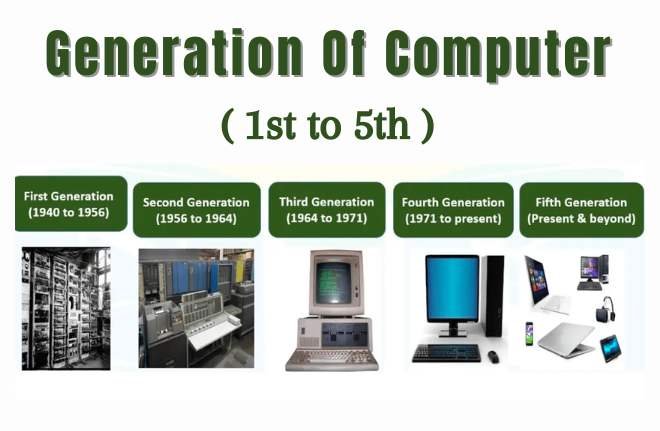Evolution Of Computers
The evolution of the Computer has been there for a long time since the Computer was first brought on the market. The computer has always been an important device in our life since its usage and there are a total of Five generations of computers produced to date. The process of evolution of computers also includes various challenges faced and overcome with the following generations and updates. Let’s look at the evolution of computers from their beginning till now.
Devices that were used before the evolution of computers
Some devices were used popularly before the invention of modern computers. Such devices are as follows
- Abacus
- Arithmometer
- The Difference Engine
- Pascal’s Calculator
- Comptometer
- Comptograph etc.
Generations of Computer
Generation is a term given to describe the evolution from the 1st generation to 5th generation ( present one) and beyond. The computer was first invented in the 16th century and has been progressing since then with various features and characteristics. Given below are 5 generations of computers with their Period and hardware.
| Generations | Period | Hardware used |
| First Generation | 1940s – 1950s | Vacuum Tube Based |
| Second Generation | 1950s – 1960s | Transistor Based |
| Third Generation | 1960s – 1970s | Integrated Circuit based |
| Fourth Generation | 1970s – Present | Microprocessor Based |
| Fifth Generation | Present – Future | Artificial Intelligence Based |
First Generation Computers
First Generation computer, first introduced in 1940, was made using the technology of Vacuum tubes. These were very large and heavy in size and though not so absolute for coding, etc. The main use of first-generation computers was in televisions, amplifiers, radios, etc. The main reason behind their not-so-perfect coding includes no usage of operating systems and the low-level programming language used on them. Electricity consumption with the first generation computer was very high and they acquired a lot of space i.e., a dedicated room to fit in. Overall we can say that The first-generation computers were not ideal for the usage.

Some examples of main computers used in the First generation are:
- ENAIC- ENAIC, also known as Electronic Numerical Integrator and Computer was built by J. Presper Eckart and John V. Mauchly.
- EDVAC- EDVAC, also known as Electronic Discrete Variable Automatic Computer was developed by Von Neumann.
- UNIVAC- It was also developed by Mauchly and Eckart.
Characteristics of first-generation of computers-
- The technology used in these computers was Vacuum tubes.
- Were very big and not portable.
- Slow in working and not suitable for programming.
- The main memory of these computers was made of magnetic tapes and drums.
Second Generation computers
Second-generation computers used transistors in place of vacuum tubes and were overall powerful and faster than the First-generation computers. Those transistors were made in the Bell Labs and made the overall structure of these computers very small. The heat that evolved through the transistors was also less compared to the vacuum tubes. Second-generation computers were introduced in the 1950s and they included the use of Central Processing Unit, I/O units, and Memory unit. COBOL, FORTRAN, ALGOL, etc were programming languages used in the Second Generation of Computers.

Characteristics of Second-Generation of computers
- Uses transistors in place of Vacuum tubes.
- Second-generation computers are comparatively smaller than the first one.
- Second-generation computers include CPU, Memory Unit, and Input/Output Units.
- Some examples of Second generation computers are UNIVAC 1107, IBM 7090, PDP-8, IBM 1400 series, etc.
Third Generation Computers
The Third Generation Computers used Integrated circuits in place of Transistors and were very fast compared to the earlier generations. The ICs used in these computers had many transistors, resistors, and capacitors and were made of silicon material. The overall efficiency of the process had been increased and they used higher-level programming languages such as BASIC, etc. Minicomputers also came into light during this duration. Some examples are IBM 360, IBM 370, NCR 395, etc.

Characteristics of Third Generation of Computers
- Had IC in place of transistors.
- High-level programming languages used.
- Large magnetic disk and core were used for memory.
- Various I/O devices were there.
Fourth Generation Computers
Fourth-generation computers include microprocessors that include all circuits for performing various functions such as logic, arithmetic, etc in a single chip. The fourth generation also defined the portability of computers as they were very compact. Private computers and technologies such as Multiprocessing, Virtual Memory, and Multi Programming, etc were also introduced during the time frame.
Some examples of Fourth-generation computers are the IBM PC, Apple Macintosh, etc.

Characteristics of Fourth-Generation of Computers
- Built using Microprocessors and technologies such as Multiprocessing and virtual Memory were introduced.
- RAM, ROM, etc. were used for memory.
- I/O devices such as keyboards, monitors, Optical Scanner, Printer, etc were introduced.
Fifth Generation Computers
The Fifth Generation or the latest generation to date has been built using Artificial Intelligence technology, bringing human intelligence to computers. The sizes of these computers are very compact and are portable by nature while the speed is very fast. Features such as AI-based Voice recognition, etc were introduced. Fifth-generation computers also use Ultra Scale Integration technology along with AI and parallel processing technology. Some examples of Fifth Generation Computers include Laptop, Desktop, Smartphones, Tablet, etc.

Characteristics of Fifth Generation of Computers.
- Uses Parallel Processing, Artificial Intelligence, and ULSI technology.
- Very small in size and portable by nature.
- Fifth-generation computers are very fast.
- Input and Output devices such as Pen, Trackpad, Mouse, Keyboard, Monitor, etc are there.

